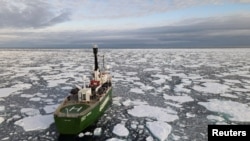Scientists with the U.S. space agency NASA say satellite data show Arctic sea ice cover this year shrank to the second-lowest level since modern record keeping began in the late 1970s.
NASA scientists and researchers at the University of Colorado Boulder’s National Snow and Ice Data Center (NSIDC) reported Monday that analysis of satellite data shows the 2020 minimum extent of ocean covered in ice, 3.74 million square kilometers, was likely reached Sept. 15.
The data shows the minimum extent of Arctic sea ice in the summer has dropped markedly in the last two decades. The lowest extent on record was set in 2012. Last year’s extent was tied for second — until this year.
NASA sea ice scientist Nathan Kurtz said 2020 was “a really warm year in the Arctic.” A Siberian heat wave in spring 2020 began this year’s Arctic sea ice melt season early. With Arctic temperatures being 8 to 10 degrees Celsius warmer than average, the ice extent kept declining. Kurtz said the earlier the melt starts, the more that is generally lost.
In addition, NASA says a recent study showed that warmer water from the Atlantic Ocean, which is typically deep below the colder Arctic waters, is creeping closer to the bottom of the sea ice and warming it from below.
NSIDC Director Mark Serreze said the amount of summer sea ice in the Arctic can impact local ecosystems, regional and global weather patterns, and ocean circulation. Warmer ocean temperatures eat away at the thicker multiyear ice, and also result in thinner ice to start the spring melt season.
Melt early in the season results in more open water, which absorbs heat from the sun and increases water temperatures.
Serreze said this second-lowest extent of sea ice on record is just one of many signs of a warming climate in the north. He also noted that signs of a warming climate include the Siberian heat waves, forest fires, hotter-than-average temperatures over the Central Arctic, and the thawing permafrost that led to a Russian fuel spill earlier this year.








